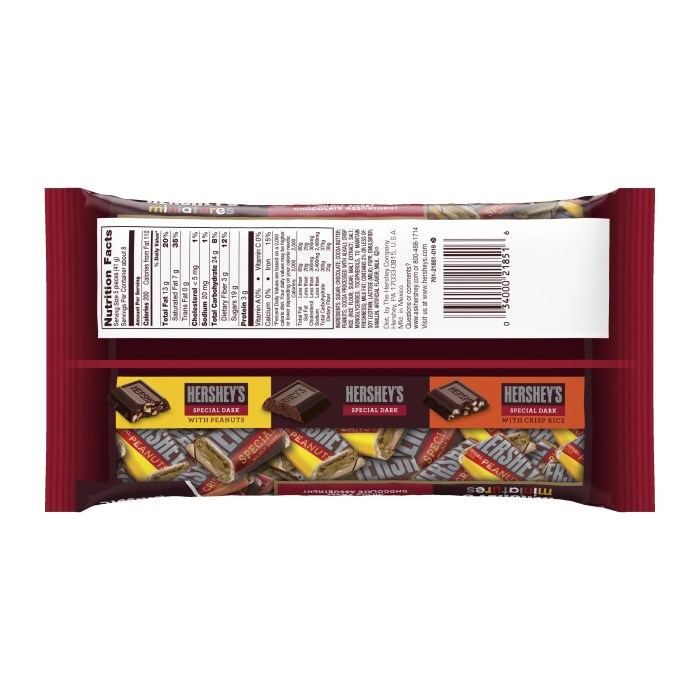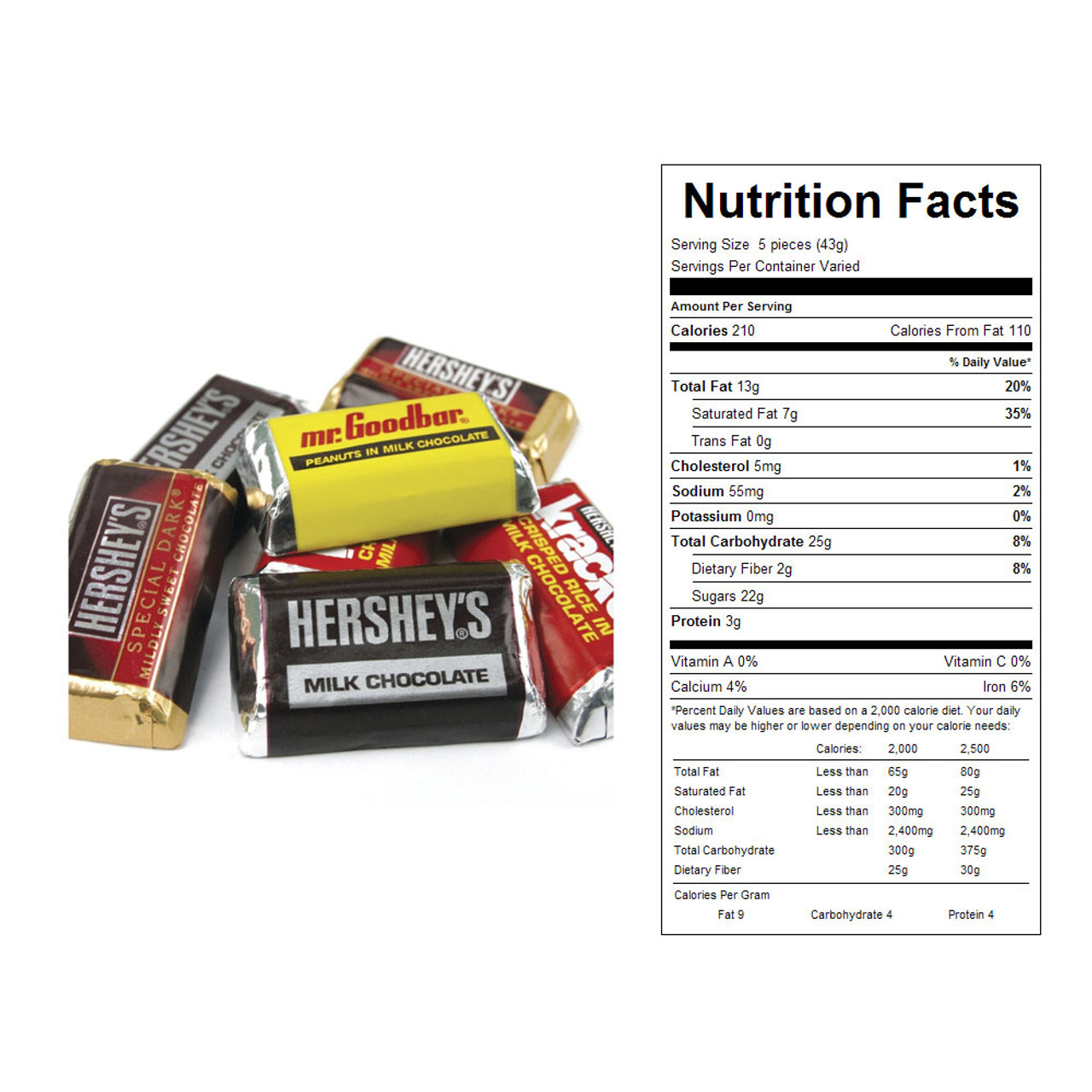Nutritional Content Overview: Mini Hersheys Chocolate Bar Nutrition Facts

Mini hersheys chocolate bar nutrition facts – Mini Hershey’s chocolate bars, while undeniably delicious, are a source of concentrated sugars and fats. Understanding their nutritional profile is crucial for making informed choices about their consumption as part of a balanced diet. This section will detail the nutritional information of a typical Mini Hershey’s bar and compare it to a standard-sized bar.
Mini Hershey’s Chocolate Bar Nutritional Information, Mini hersheys chocolate bar nutrition facts
The nutritional content can vary slightly depending on the specific variety and manufacturing batch, but a typical Mini Hershey’s bar (approximately 0.9 ounces or 25.5 grams) provides the following nutritional information. Note that these values are approximations and should be checked against the packaging of the specific product you are consuming.
| Nutrient | Amount per Serving | % Daily Value | Unit |
|---|---|---|---|
| Calories | 90 | 4.5% | kcal |
| Total Fat | 5g | 6% | g |
| Saturated Fat | 3g | 15% | g |
| Trans Fat | 0g | – | g |
| Cholesterol | 0mg | 0% | mg |
| Sodium | 15mg | 1% | mg |
| Total Carbohydrate | 12g | 4% | g |
| Dietary Fiber | 0g | 0% | g |
| Total Sugars | 10g | – | g |
| Added Sugars | 10g | 20% | g |
| Protein | 1g | 2% | g |
Significance of Key Nutrients
The high sugar content is a prominent feature. Sugar provides quick energy but excessive intake can contribute to weight gain, tooth decay, and other health problems. The fat content, primarily saturated fat, can raise LDL (“bad”) cholesterol levels if consumed in large quantities over time. While the protein content is relatively low, it still contributes to the overall nutritional profile, albeit minimally.
The lack of fiber is also noteworthy; fiber aids digestion and promotes satiety.
Mini Hershey’s chocolate bar nutrition facts often highlight the high sugar content, a stark contrast to the nutritional profile of a balanced meal. For comparison, consider the nutritional information for other popular fast food options, such as nutrition facts raising cane’s , which generally showcase higher fat and calorie counts. Returning to the mini Hershey’s bar, understanding its nutritional breakdown helps in mindful snacking and portion control.
Comparison to a Standard-Sized Hershey’s Bar
A standard-sized Hershey’s milk chocolate bar is considerably larger than a Mini version, resulting in a significantly higher calorie, fat, and sugar content. The following bulleted list illustrates a general comparison, keeping in mind that precise values vary depending on the specific product:
- A standard Hershey’s bar contains roughly 210-230 calories compared to the Mini’s approximately 90 calories.
- The standard bar has considerably more total fat and saturated fat than the Mini bar.
- The sugar content is proportionally higher in the standard-sized bar.
- The protein content is also proportionally higher in the standard-sized bar, but still remains a small component of the overall nutritional profile.
Ingredient Analysis

Understanding the ingredients in a Mini Hershey’s chocolate bar provides insight into its flavor profile and potential health effects. The simple ingredient list belies a complex interplay of components that contribute to the bar’s characteristic taste and texture. This section details the ingredients and their roles, as well as the potential health implications of consuming them.
The ingredients in a Mini Hershey’s chocolate bar typically include:
- Sugar: The primary sweetener, providing sweetness and acting as a preservative. It contributes significantly to the overall flavor and palatability of the bar.
- Chocolate Liquor (unsweetened chocolate): This is the base of the chocolate, containing cocoa solids and cocoa butter. It provides the characteristic chocolate flavor and contributes to the bar’s texture.
- Milk Fat: Contributes to the creamy texture and rich flavor of the milk chocolate. It also adds to the overall fat content.
- Cocoa Butter: A natural fat found in cocoa beans, contributing to the smoothness, melt-in-your-mouth texture, and glossy sheen of the chocolate.
- Lactose: A natural sugar found in milk, adding sweetness and contributing to the overall flavor profile.
- Soy Lecithin (emulsifier): Helps to blend the ingredients together smoothly, preventing separation of the cocoa butter and other components.
- Salt: Enhances the overall flavor profile of the chocolate and balances the sweetness.
- Artificial Flavor: Used to enhance and standardize the chocolate flavor, ensuring consistency across different batches.
Health Implications of Ingredients
Consuming high amounts of sugar and saturated fat, both present in Mini Hershey’s bars, can have several potential health implications. High sugar intake is linked to weight gain, type 2 diabetes, and dental problems. Excessive saturated fat consumption can contribute to high cholesterol levels, increasing the risk of heart disease. Moderation in consumption is key to mitigating these risks.
The relatively small size of a Mini Hershey’s bar helps control portion sizes, but frequent consumption can still contribute to overall daily intake exceeding recommended limits.
Ingredient Comparison: Mini Hershey’s vs. Another Brand
The following table compares the ingredients of a Mini Hershey’s chocolate bar to a similar-sized dark chocolate bar from a different brand (for example, a mini Dove dark chocolate bar). Note that specific ingredient lists may vary slightly depending on the specific product and manufacturing batch.
| Ingredient | Mini Hershey’s Milk Chocolate | Mini Dove Dark Chocolate (Example) | Notes |
|---|---|---|---|
| Sugar | High | Low/None (depending on specific variety) | Hershey’s uses sugar as a primary sweetener, while dark chocolate often relies less on added sugar. |
| Cocoa Butter | Present | Present | Both bars use cocoa butter for texture and flavor. |
| Milk Solids | Present | Absent | Hershey’s is milk chocolate; Dove dark chocolate is typically dairy-free. |
| Cocoa Mass | Present | High | Dark chocolate has a significantly higher percentage of cocoa mass. |
Serving Size and Calorie Information

Understanding the serving size and calorie content of Mini Hershey’s chocolate bars is crucial for managing daily caloric intake and making informed dietary choices. This section details the serving size as indicated on the packaging and provides examples to illustrate how calorie consumption increases with the number of bars consumed.A single Mini Hershey’s chocolate bar typically constitutes one serving.
The exact calorie count may vary slightly depending on the specific variety, but a standard Mini Hershey’s bar usually contains around 70-80 calories. This relatively small calorie count might seem insignificant on its own, but consuming multiple bars quickly adds up, impacting overall daily caloric intake. It’s important to consider this when incorporating Mini Hershey’s into a balanced diet.
Calorie Calculation for Multiple Mini Hershey’s Bars
Calculating the total calories consumed from multiple Mini Hershey’s bars is straightforward. Assuming an average of 75 calories per bar (a reasonable approximation for most varieties), we can use a simple formula:
Total Calories = Number of Mini Hershey’s Bars x Calories per Bar (approximately 75)
Let’s consider a few examples:* One bar: 1 bar x 75 calories/bar = 75 calories
Two bars
2 bars x 75 calories/bar = 150 calories
Five bars
5 bars x 75 calories/bar = 375 caloriesThese examples demonstrate how quickly calorie intake increases with increased consumption. Even seemingly small indulgences can contribute significantly to daily caloric intake, especially when added to other food and beverages.
Visual Representation of Caloric Content
Imagine a bar graph. The horizontal axis represents different snacks, and the vertical axis represents calorie content. One bar represents a Mini Hershey’s chocolate bar with a height corresponding to approximately 75 calories. Next to it, a bar representing a small apple (around 95 calories) would be slightly taller. A bar for a medium-sized bag of potato chips (around 150-200 calories) would be significantly taller than both the Mini Hershey’s and the apple.
Finally, a significantly taller bar representing a slice of pizza (around 250-350 calories) would illustrate the relative calorie density compared to the Mini Hershey’s. This visual comparison helps to contextualize the calorie content of a Mini Hershey’s bar within the broader context of common snack options.
FAQ Explained
Are Mini Hershey’s bars suitable for people with diabetes?
Due to their high sugar content, Mini Hershey’s bars should be consumed sparingly by individuals with diabetes and incorporated into a carefully managed diet plan.
How many mini Hershey’s bars equal one serving?
The serving size varies depending on the package, so always check the label for the specific information. Typically, a serving consists of one or more bars.
Are there any artificial ingredients in Mini Hershey’s bars?
Check the ingredient list on the packaging for specific details. While the primary ingredients are typically cocoa, sugar, and milk solids, the presence of artificial ingredients can vary.
How do Mini Hershey’s bars compare to dark chocolate in terms of health benefits?
Dark chocolate generally contains higher levels of antioxidants and less sugar than milk chocolate like Mini Hershey’s, offering potential health advantages.


